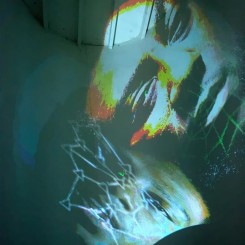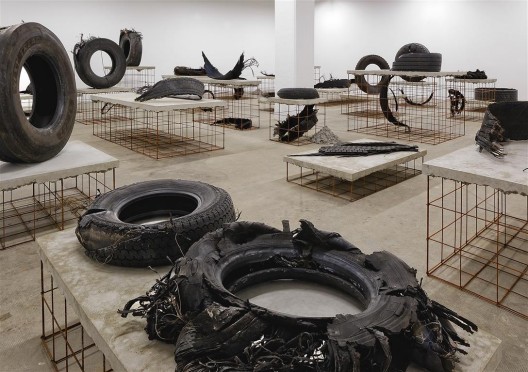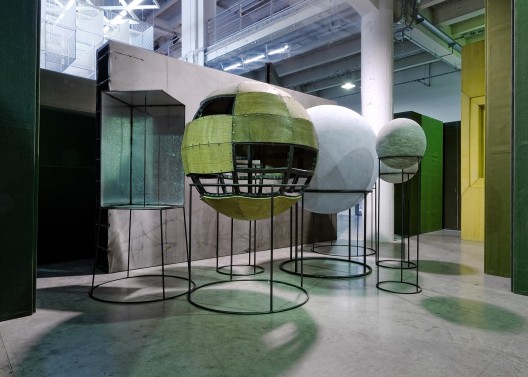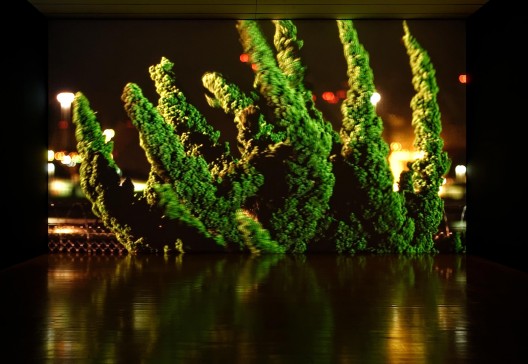“La Vie Moderne”: 13th Lyon Biennial
Across five venues in Lyon. Sep 10, 2015–Jan 3, 2016
Titling a biennial “Modern Life” is a bold move, but this is what the artistic director of the Lyon Biennale, Thierry Raspail, has chosen to do. The biennial unites 60 artists from 28 countries and shows 300 works across three venues, the Musée d’art contemporain, the Sucrière, an old warehouse, and the modish Musée des Confluences.
There is an emphasis on French artists, and artists from the francophone African diaspora, such as Sammy Baloji, Mohamed Bourouissa, Emanuelle Lainé and Laura Lamiel. Asian artists play a lesser role, but nonetheless, Liu Wei and Yuan Goang-Ming’s works are key for the exhibition’s structure. A still from Yuan Goang-Ming’s work “Landscape of Energy” (2014) showing a dystopian Taiwanese beachscape with a looming nuclear plant is used as the image for the biennial’s promotional material and entryway backdrop. The diversity of the works on display, of which the majority were commissioned, makes for a fulfilling visitor experience free of the bombast that often accompanies large-scale biennials. Despite this, Raspail’s intention to “explore the conditions of contemporary life” via a re-reading of the “Modern” is beset by problems.
The Lyon Biennale is unusual in that the artistic director chooses a theme which is then implemented by a curator–in this case Ralph Rugoff, the chief curator at the Hayward Gallery in London. Rugoff told Randian “We’re looking at different aspects of today and how artists are engaging with it, but with an eye of history in many of the works, so the contemporary is not a shallow idea, but it has roots.” It appears that both Raspail and Rugoff are simply exchanging the Modern for the Contemporary in order to avoid the “deracinated perpetual present” implied by the term “contemporary.” This is a dubious strategy, however, as it proves impossible to ignore the art-historical and formal connotations of the term “Modern” when thinking through the Biennial’s subject. Charles Baudelaire’s dictum on Modernity reads that “Modernity is the transient, the fleeting, the contingent, it is one half of art, the other being the eternal and immovable”. During the Modern period, the grand narrative of art-historical progress, with its Greenbergian acme of medium-specificity, bound the two halves. The “contemporary”, however, has dropped the second half of the dictum in favor of the first: the transient and the fugitive are privileged, and the historic specificity of the work is lost, as Hal Foster wrote in his ‘Questionnaire on the Contemporary.’ This is what Raspail’s return to the Modern is trying to resist.
Rugoff identified four main themes of Modern Life, mirroring the grand narratives of modernism: economic life, immigration and national identity, spaces and times, and mediated nature. An exploration of these themes could have taken the form of examining older works in combination with newer ones, thus enabling a variegated view of artistic interpretation. Instead, the artworks (which are mainly new, with a high number of commissioned pieces) are parsed as palimpsests that supposedly allow a reading of the past in the present. This includes Cyprien Gaillard’s work “Nightlife”, a beautifully rendered 3D film in which Rodin’s sculpture “The Thinker” makes an appearance—before Gaillard homes in on trees dancing in the wind, and ends with drone footage of fireworks. The allusion to Rodin is supposed to render this as a palimpsest, but a mere visual reference does not imply an intellectual or aesthetic connection. The work, standing outside this context, nevertheless raises interesting questions regarding the boundary between sculpture and projection, between image and object.
In her interactive work “Hello & Thank you” (2015), the French artist Camille Henrot turns her attention to the economic optimization and resulting frustrations of everyday life. A sculpture of an ear and a large touchpad, when touched, accessed a helpline advice “tree”. However, instead of this being dedicated to, say, fixing your DSL line, the machine gave gender-specific advice on typical consumer issues: sleeplessness, teenage angst, the loss of a loved one, sexual problems, work worries and so on. Yet rather than resolving the issue, the caller is told that they have run out of credit. The piece addressed how “our emotions are managed in a corporate culture”, as Rugoff explained. Again, it is not entirely clear how this work reflects past narratives, yet as a piece on its own, it functions well as a tongue-in-cheek commentary on one of the alienating annoyances of everyday life, and how individual subjectivity is effectively swept aside in favor of corporate efficiency.
Spectacularly opening the main venue of the Biennale, the Sucrière, Liu Wei’s installation “Enigma” looms large. Oversized resin blocks in camouflage green and yellow, steel poles, oilcloths and a video projection block the entranceway so that the visitor must negotiate this labyrinth before gaining access to the main floor of the exhibition. The overall feeling is one of claustrophobia, and indeed, the artist’s work is intended as a metaphor for the rapidly expanding megalopolises that are currently exploding in the East.
The Taiwanese artist Yuan Goang-Ming takes a dystopian beachscape wherein cheerful umbrellas abut a decaying plant as a starting point for his video installation “Landscape of Energy”, a drone voyage through contemporary Taiwan. In another piece, the four channel video installation “Before Memory” (2011) juxtaposes drone flights through jungle-scapes and desolate housing estates with underwater footage and aerial views of an abandoned copper mine. The ruins of civilization are contrasted with “nature”—but it is an artificial, mediated concept of nature. Tight editing and the quick juxtaposition of close-ups, aerial views and shifting perspectives are reminiscent of Cyprien Gaillard’s piece. This is the first biennial where I have seen so much video work shot by drone—an intriguing development that promotes perspectives removed from the human: dizzying, aerial and alien.
An intriguing set of works tackle the specificities of meaning as cultural artifacts. Kader Attia’s piece “Réparer l’Irréparable” comprises of 18 videos which reflect on psychiatric pathology in both Western and non-Western perspectives via a series of interviews with philosophers, ethnologists, historians, healers and fetishists. The Congolese artist Sammy Baloji juxtaposes old, colonial photographs by the Belgian Commander Henri Pauwels with work by Chrispin Mvano, a journalist from the war-torn Congolese province North Kivu.
Many works play with ecological processes and the built environment: Hicham Berrada interferes with the diurnal cycle of night-blooming jasmine, leading visitors into a dark, scented chamber filled with the flower. At night, the flower is lit by a horticultural lighting system. In contrast, Magdi Mostafa represents the buildings of Cairo as installation of 10 000 LED bulbs, fed by 15 power centers in an expansive installation, sound-tracked by a collage of Cairo’s street sounds. Mike Nelson creates environments of tire treads he finds by the motorway, ripped and torn from impact, a plump but effective reminder of the speed of the consumption of natural resources. In the tradition of Richard Prince’s rephotographed advertising campaigns (e.g. Four Women Looking in the Same Direction, 1977), Nguyen Trinh Thi’s work shows “landscape as the silent witness of history”, and takes the shape of an assemblage of found press photographs of people pointing at something unseen in the distance—a drama, a disappearance, a gap in the narrative.
While the Biennial leaves one with little impression of what the term “Modern” means today, it allows for leisurely discovery of new artwork from a very diverse group of voices. The pace never feels hurried, the installation allows for an in-depth exploration of most pieces. While Rugoff seems to have had his problems with the concept he was given, this has not dulled a presentation of contemporary art that allows the visitor to discover new positions and tackle previously unknown subject matter.
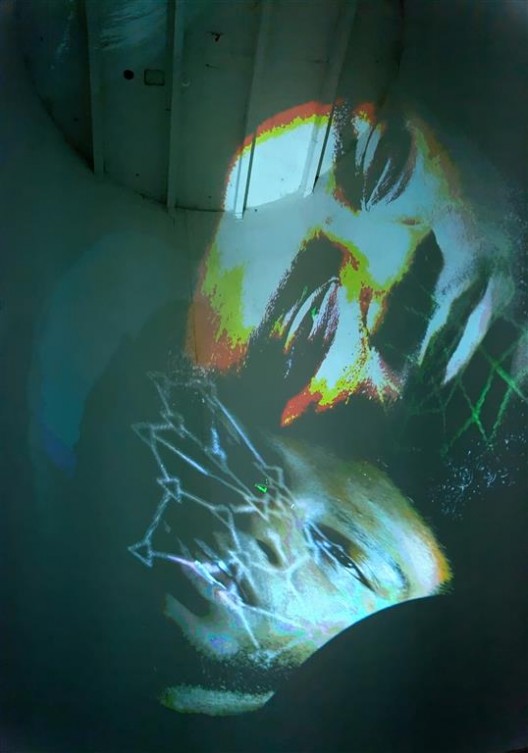
Tony Oursler, “Weak-classifiers” 2015. Courtesy Lisson Gallery, New York and the Biennale de Lyon 2015 ©Blaise Adilon.
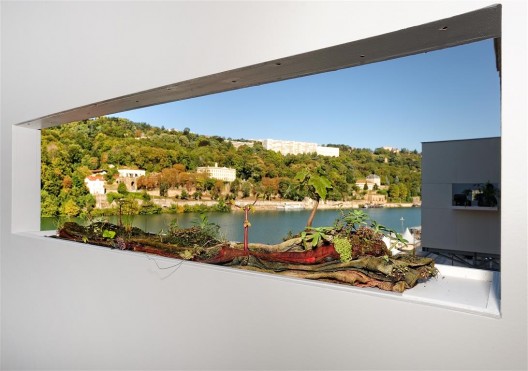
Michel Blazy, “Pull Over Time”, 2015. Courtesy of the artist, ArtConcept and the Biennale de Lyon 2015, ©Blaise Adilon, ADAGP Paris 2015.
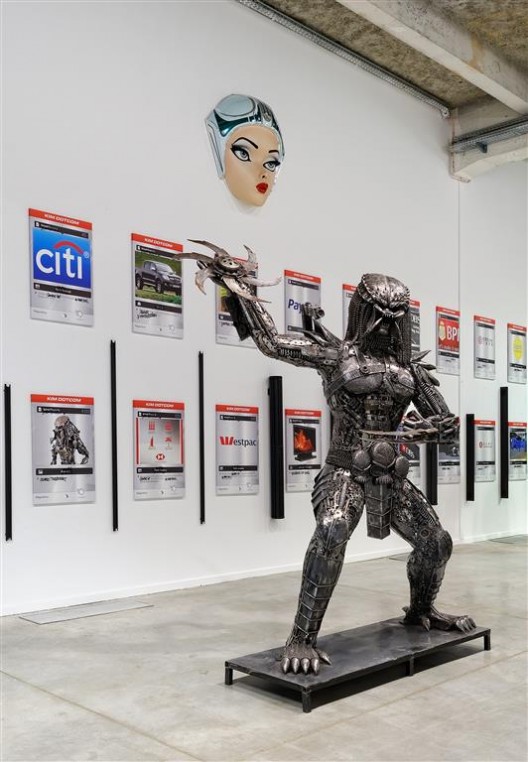
Simon Denny, “The personal effects of Kim Dotcom”, predator statue. Courtesy of Mumok, Vienne and the Biennale de Lyon 2015, ©Blaise Adilon.
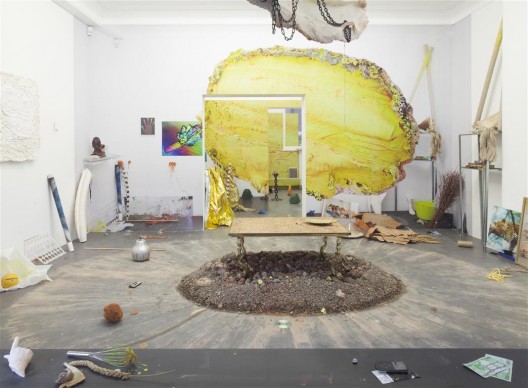
Emmanuelle Lain, “Don’t cheat me out of the fullness of my capacity!”, 2014. Courtesy Emmanuelle Lain.
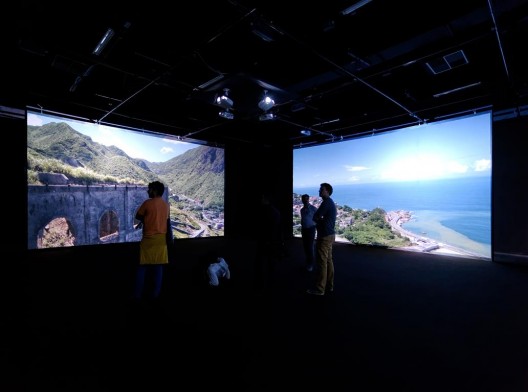
Yuan Goang-Ming, “Before Memory”, 2011. Collection of Taipei Fine Arts Museum, Taiwan and courtesy of the Biennale de Lyon 2015, ©Blaise Adilon.

